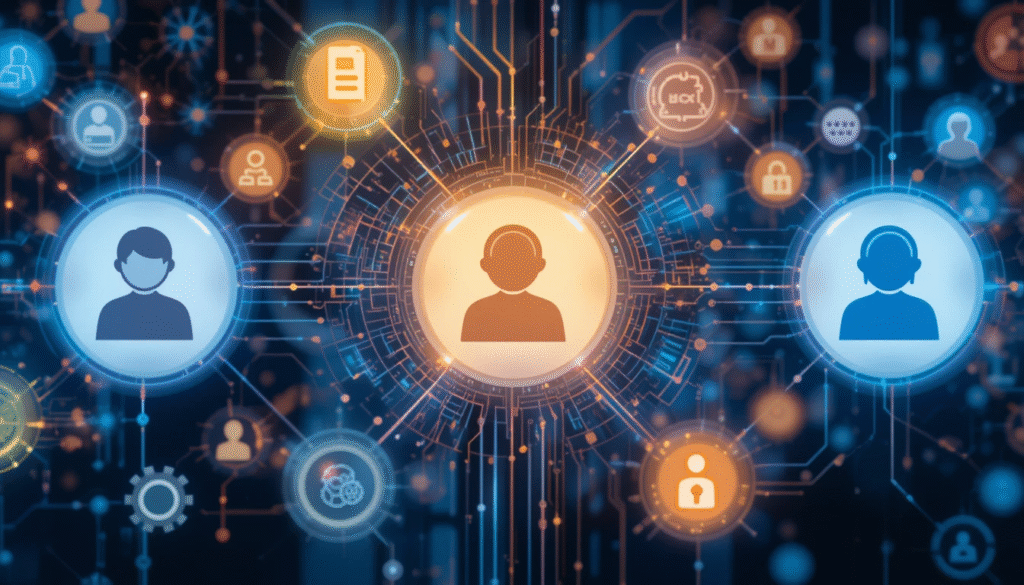Table of Contents
Introduction
In IT environments, accounts are like digital identities. Whether it’s a person accessing emails, an app pulling data, or the operating system managing its core, each uses a different type of account. The three core types are:
- User Accounts
- Service Accounts
- System Accounts
Understanding and identifying these account types helps improve access control, security posture, and operational visibility. Let’s break down the differences, real-world examples, risks, best practices, and crucially, how to identify each.
1. What Are User Accounts?
User accounts are created for real people who need to interact with systems and services.
🔹 Purpose:
To allow individuals to log in, interact with applications, and perform tasks based on permissions.
🔹 Key Traits:
- Interactive login enabled
- Personal credentials (username/password or MFA)
- Mapped to roles like admin, standard, guest
- Personalized data and session settings
🔹 Examples:
john.doe@company.comaccessing Office 365admin123logging into a Linux server- Employees using Active Directory accounts
2. What Are Service Accounts?
Service accounts are non-human accounts created for automated processes, background tasks, or application access.
🔹 Purpose:
To allow applications or scripts to access resources or execute tasks without user interaction.
🔹 Key Traits:
- Non-interactive
- Typically no mailbox or GUI
- Often named with prefixes like
svc_,app_,bot_ - Custom permissions to reduce risk
🔹 Examples:
svc_backupused for scheduled backupsapp_datafeedthat pulls reports via API- Azure-managed identities and AWS IAM roles
3. What Are System Accounts?
System accounts are created by the operating system for essential functions and background services.
🔹 Purpose:
To run OS processes and services necessary for basic system functionality.
🔹 Key Traits:
- Built-in by the OS
- Cannot be deleted or used interactively
- Have high privileges (e.g., SYSTEM or root)
🔹 Examples:
root,daemon,nobodyin LinuxNT AUTHORITY\SYSTEMin WindowsLocalService,NetworkService
4. Key Differences Between the Accounts
| Feature | User Account | Service Account | System Account |
|---|---|---|---|
| Human Login | ✅ | ❌ | ❌ |
| Created By | IT/Admin | IT/DevOps/Script | OS |
| Purpose | User interaction | Automation/Scripting | OS Operations |
| Example Names | jane.doe | svc_sql, api_reader | root, SYSTEM |
| Risk if Misused | Medium–High | High | Critical |
| Permissions Scope | Role-based | Task-specific | Kernel/system-wide |
| Can Be Disabled | ✅ | ✅ (with caution) | ❌ |
5. How to Identify These Accounts
A. Identifying User Accounts
🔹 In Windows:
powershellCopyEditnet user
🔹 In Linux:
bashCopyEditcat /etc/passwd
Look for UIDs ≥ 1000 (standard users).
🔹 In Active Directory:
powershellCopyEditGet-ADUser -Filter *
🔹 In Azure:
bashCopyEditaz ad user list
B. Identifying Service Accounts
🔹 Windows:
- Open Services.msc and check “Log On As”.
- PowerShell: powershellCopyEdit
Get-WmiObject Win32_Service | Select Name, StartName
🔹 Linux:
bashCopyEditawk -F: '($3>=1)&&($3<1000){print $1}' /etc/passwd
🔹 Azure:
bashCopyEditaz ad sp list
🔹 AWS:
bashCopyEditaws iam list-roles
C. Identifying System Accounts
🔹 Windows:
- Built-in:
LocalSystem,NetworkServiceNT AUTHORITY\SYSTEM
powershellCopyEditGet-LocalUser | Where-Object {$_.Description -match "Built-in"}
🔹 Linux:
bashCopyEditawk -F: '($3<100){print $1}' /etc/passwd
🖥️ D. Identifying Machine Accounts (Usernames Ending with $)
Usernames ending with a dollar sign ($) are computer or machine accounts in Active Directory.
🔹 Purpose:
- Represent machines (e.g.,
WIN10-PC1$) joined to a domain. - Authenticate the computer to the domain controller.
🔹 Created Automatically When:
- A Windows machine is added to an AD domain.
🔹 Examples:
DESKTOP-5F9G5K3$SQL-SERVER01$
🔹 How to View:
powershellCopyEditGet-ADComputer -Filter *
6. Real-World Use Cases
✅ User Account:
- Sarah logs into her cloud dashboard to approve expenses.
✅ Service Account:
- A CI/CD tool uses
svc_deployerto update applications automatically.
✅ System Account:
SYSTEMexecutes Windows Update and logs system events.
✅ Machine Account:
WEB-SERVER01$authenticates with the AD controller to fetch GPO settings.
7. Risks and Security Implications
| Account Type | Common Risks |
|---|---|
| User | Phishing, password reuse, privilege abuse |
| Service | Hardcoded credentials, excessive privileges |
| System | Exploitable by malware/rootkits |
| Machine | Stale computer objects, compromised endpoints |
8. Best Practices for Management
🔐 User Accounts:
- MFA, RBAC, auto-lock for inactivity
🤖 Service Accounts:
- Use managed identities or secrets vaults
- Restrict access and log actions
⚙️ System Accounts:
- Never run applications under
SYSTEMorroot - Monitor for unusual behavior
🖥️ Machine Accounts:
- Regularly audit stale computer accounts
- Use endpoint protection tools
✅ Conclusion
Understanding and identifying account types—user, service, system, and machine—is essential for strong identity governance and cyber defense. Each serves a different function, requires distinct access controls, and poses unique risks if not managed properly.
